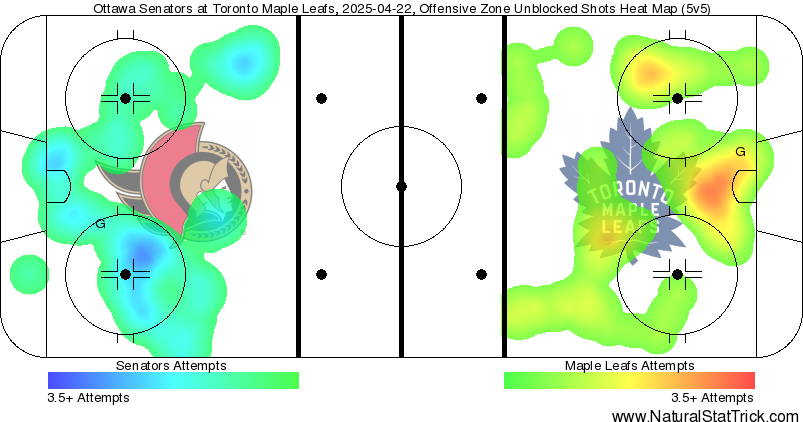It seemed like this would be a straightforward series after the first 20 minutes of Game 2. It then turned into a nail-biter requiring overtime.
Funny enough, nobody embodied this rollercoaster more than Max Domi, whom I tweeted should be benched at the end of regulation. He ended up scoring the overtime winner some 30 minutes later — some redemption after a mediocre 120 minutes for him so far in the series, and a huge goal to give the Leafs a commanding 2-0 series lead.
To Craig Berube’s credit, he has done this all season: give struggling players second, third, and even fourth chances. It can be maddening at times, but boy, did it pay off tonight.
Ottawa will rightfully note that they haven’t played on home ice yet, and the series is by no means over, but they will now need to win four of five. The Leafs have taken a 2-0 series lead for the first time since 2002.
Your game in 10:
1. The game started with two familiar scripts from Game 1: Craig Berube kept the line matching the same, and the Leafs came out flying.
The Senators mixed it up off the opening draw by starting the Dylan Cozens line, which meant the Scott Laughton line took the opening faceoff. Frankly, I prefer this for the Leafs because that line did exactly what we knew they would: got the puck in deep, went to work on the forecheck, recovered it, and got a nice cycle going.
While Jake McCabe’s point shot ultimately went wide, that wasn’t the point. They established zone time and immediately tilted the ice. Let us never call this the fourth line again. They are the third line.
On the next shift, the Leafs‘ second line with Pontus Holmberg on it caught Ottawa on a breakout, and Holmberg went on a breakaway that he tried to shoot five-hole. He’s tried that move a few times (it’s actually how he scored his first career NHL goal), but it’s not particularly effective given his overall inability to shoot.
On the next shift, Auston Matthews and Matthew Knies teamed up for a heavy forecheck where Knies eventually centered a pass to Mitch Marner that he put off the post (I think Marner had a bit more time than he realized).
Nonetheless, this was another big-time start: Immediate cycle, a breakaway, and a post off a heavy forecheck. We said it last game, but this is how you start games — by getting after it.
2. The pressure quickly paid off when the Leafs took a 1-0 lead not even four full minutes into the game.
Following an offensive-zone faceoff that John Tavares won (yet again), the Leafs went to work as Holmberg tipped a shot wide, then missed a follow-up in the slot. Tavares picked it up in the corner, brought it up the wall, and cycled it back low to Nylander, who slipped under him.
While all of that was happening, Morgan Rielly was quietly sneaking to the backdoor — the exact kind of involvement you want to see from #44. He went long stretches this season where he was completely static on the blue line, but he’s now jumping in and looking to activate.
As Rielly snuck low and Nylander collected the puck, he squared up Thomas Chabot one-on-one and made a move we’ve seen a million times now: fake like he’s going to circle high and aggressively cut back on his edges (which are elite). That cutback created space for him to throw an absolute dart through traffic — which Holmberg was providing in front — and right to Rielly backdoor, who made a small but important play to open up his skate blade but not actually kick it, deflecting the puck into the net for his second goal in as many games.
Playoff Rielly is present and accounted for so far. He is now tied for the most playoff goals by a defenseman in Leafs history with 13.
Rielly 2nd of the Playoffs vs Senators courtesy of @Bonsie1951 and @Jim_Ralph (4/22/25) pic.twitter.com/FSgCC0QD4z
— Maple Leafs Hotstove (@LeafsNews) April 23, 2025
3. A minute after the Leafs took the lead, Chris Tanev took a penalty. The Sens generated good possession on the power play, and Anthony Stolarz made four saves, but ultimately, the Leafs killed it off for a big early kill.
When the penalty expired, Ottawa was still pouring on pressure, and it got a bit awkward when the Leafs returned to even strength as Tanev returned to the zone and was forced to play wing, giving the Leafs three defensemen. Tanev ultimately made a really good play to control the puck and settle the play down, leading to a big momentum-changing shift where Nylander tipped a puck to Tavares on the breakout. It led to a 2v1 that ended with Holmberg drawing a penalty.
Holmberg led the team in penalties drawn this season because he outworks defenders and constantly moves his feet. He did it again here, and it was a huge swing in the period. Just 18 seconds into the power play, the Leafs doubled their lead.
Once again, Tavares won the faceoff to establish possession, and from there, the goal didn’t have a ton to break down, but the Leafs’ movement was noteworthy. On the goal itself, Tavares was on the half-wall, and Matthews was in the bumper spot, which speaks to how the Leafs rotate now rather than standing still in their spots on the PP (as they have in years past).
Matthews drew a lot of attention in the bumper, and Tavares faked hitting him before pulling back and looking to the net, where Knies was his usual immovable self. Tavares threw it to the net, where it deflected off Ullmark, off Nick Jensen (who was covering Knies), and into the net.
There was so much talk about dealing with Brady Tkachuk in front of the Leafs’ net, but one thing we flagged before the series in this space was the Senators’ relatively soft defense. Who could deal with Knies? So far, nobody. Knies didn’t pick up a point on the goal, but he was a huge factor in it.
Tavares 2nd of the Playoffs vs Senators courtesy of @Bonsie1951 and @Jim_Ralph (4/22/25) pic.twitter.com/yrGCrDYTF1
— Maple Leafs Hotstove (@LeafsNews) April 23, 2025
4. One area where the Leafs were much improved in the first period was their breakouts. They were stringing together passing sequences and moving the puck up the ice cleanly. In Game 1, the Senators’ defensemen jumped all over the Leafs defensemen rimming pucks around the walls. Craig Berube noted their breakouts needed to be better between games, and they did a better job of it in the first period. Their defense was moving it to each other, controlling the pace, and finding open forwards up ice with much tighter exits where the Leafs were closer together as a unit.
The Leafs out-attempted Ottawa 16-12 at five-on-five in the first period and out-chanced them in the high-danger area 4-1 overall. The Leafs thoroughly outplayed the Senators across the board in the first, and by the end of it, Tkachuk was rattled and attempted to take cheap shots at Leafs players after the whistles (Matthews and Tavares on separate plays).
Sportsnet recorded the Leafs winning 85 percent of the battles in the first. It was about as good a start as the Leafs could’ve hoped for.
5. For as strong as their first period was, the second period was absolutely horrendous from the Leafs. The ice immediately tilted against them, and it lasted for nearly the entire 20 minutes. Ottawa generated 27 shot attempts at five-on-five in the second and 34 overall — which includes two power plays — leading to 13 shots total.
The Leafs mustered just three shots on net in the period, and while sometimes shots don’t tell the story, it does in this case. They were thoroughly dominated, and over the past month, they’ve battled this habit of basically taking a period off. They did it against Carolina most recently, and they did it against both Tampa and Florida the week before. As tidy as their breakouts were in the first, they were nonexistent in the second, as they were constantly jammed up on the walls.
The highlight of the period for the Leafs was Stolarz getting a pound of flesh back on Ridly Greig, getting multiple whacks in and a punch, somehow resulting in coincidental penalties.
6. Ultimately, the Senators scored a much-deserved goal to cut the lead in half. You could bemoan the luck of the goal slightly — it deflected off Brandon Carlo and in — but when you outplay a team for a full period, you generally get the bounces.
Craig Berube definitely didn’t like the penalty leading to the goal. The Leafs seemed to be working their way out of their mid-game malaise and possessed the puck in the Senators’ zone, but Nick Robertson took a careless high-sticking penalty in the corner of the offensive end after the puck was gone. It’s a really bad penalty to take, and Robertson only played three shifts afterward, including a benching right after.
Robertson took eight total penalties this season, but five of them came in his final 18 games between March and April, and several of them were just like this one. It simply can’t happen from essentially the team’s 12th forward.
Much like the Leafs’ power-play goals, the Senators won the faceoff then quickly capitalized. They worked it down to Tkachuk for a down-low 2v1 with Carlo defending, and while Carlo made the right play to tie up at the backdoor, the puck bounced off his skate, giving Ottawa life.
7. The Leafs got off to a good start to the third period in response to the Senators’ 2-1 goal. They created two big chances for the insurance goal; one was a Tavares breakaway where he seemed to overthink until he didn’t have room left, and the other was a Marner one-timer off a Matthews faceoff win, similar to the goal they scored against Nashville. Matthews also created decent chance of his own on the wraparound play that he loves (far-side wraparound attempt), just missing the initial play, and Knies just missed the ensuing rebound. They definitely didn’t sit back.
12 minutes into the third, the shots were 7-0 Leafs, and while shot attempts were even, the Leafs were packing the house and making it miserable for Ottawa to get anything through while generating some decent offensive looks to extend the lead. The Leafs even started sneaking out the Matthews line against other (i.e., not Stutzle) Senators lines to push for the goal in a controlled way, using the Laughton line to backfill against the Stutzle unit and ensuring the McCabe-Tanev pairing was on against Ottawa’s top line at all times. However, the Leafs couldn’t find the next one.
8. Ottawa tied the game on their first shot on net of the period. The goal resulted from turnover on a miscommunication between Oliver Ekman-Larsson and Max Domi. OEL skated behind the net, looking to reverse it to Domi the whole way. It was very clear the entire time that’s what OEL wanted to do, as his partner (Benoit) was covered. The one player who didn’t know it was coming was Domi himself.
I don’t like the play from OEL or Domi, to be honest. OEL had the far-side rim available to Robertson — who was at center — for an easy out. For Domi, there was a long enough build-up on the play to see what was developing, but he was out to lunch on it.
The bigger story, perhaps, is why the fourth line was on the ice with the third pairing with five minutes left in a one-goal game. It can’t happen, under any circumstances. That’s really poor from the coaching staff, and it burned the Leafs. After the turnover, Ottawa got a point shot off, and Adam Gaudette made a nice tip down into the net. There was no real chance for Stolarz on the 2-2 goal.
9. The Leafs created some chances to end the game in regulation following the goal. Knies and Marner worked a good give-and-go sequence, but Knies couldn’t get enough on the shot off the rush with Ullmark in a vulnerable spot. Nylander cut in for a good shot on goal from a location where we’ve seen him score a ton, but the big chance wasn’t even a shot on net, ultimately.
Knies made a big-time play to get it deep, win the battle, and spin to find Matthews in the slot, who then dropped it to Calle Jarnkrok. Jarnkrok appeared to have some net to shoot at, but credit to Artem Zub, who went down to the ice and blocked it to potentially save a goal.
The Senators also created a quality chance of their own as Domi gave the puck away in the Leafs’ zone, leading to a Nick Jensen point shot where the rebound was almost whacked in, and they had a chance off the rush where Cozens trailed and got a clean shot off all alone in the high slot. Stolarz flashed the leather to send it to overtime.
I thought the Leafs played a pretty good third period when protecting the lead. The Senators finished the period with only four shots on net total and the Leafs carried the scoring chances. But they got burned on one bad play.
10. Through 60 minutes, I was ready to write about possibly healthy scratching Max Domi. To that point in the series, including Game 1, he was turning the puck over non-stop, was demoted down the lineup, and wasn’t doing much of anything positive. While I’d somewhat argue the game didn’t even need to go into overtime if it wasn’t for him, he ultimately went from zero to hero in overtime.
First and foremost, the Leaf who should receive a lot of love for the game-winning sequence is Simon Benoit. On a 3v3 rush, he jumped the cross-ice pass for a turnover and led the counterattack up ice. Benoit reached 10 points this season, and we’ve talked a lot about how he’s worked on his puck skills. He could have easily dumped the puck in and gotten a line change rolling, but he skated up and made a drop pass (!) in overtime (!) of the playoffs (!).
From there, Domi made a really good play to take the puck and cut in. Drake Batherson, who made the initial terrible pass on his backhand, committed a crazy bad flyby on Domi in the middle of the ice, opening up a great look. Domi did what everyone has been asking him to do for years now: shoot. It was a great shot and a great finish to give the Leafs a 2-0 series lead.
McCabe played a team-high 24:09, and Carlo played the least of all Leafs defensemen (18:27) as he has quietly fought some issues in the series so far. Robertson was the only forward to play less than 11 minutes (he didn’t even play 10) and is a prime candidate for a scratch in Game 3, while Marner led the Leafs forwards with 23:41.
DOMI OT WINNER TO WIN GAME 2 vs Senators courtesy of @Bonsie1951 and @Jim_Ralph (4/22/25) pic.twitter.com/jGbJGbmh2F
— Maple Leafs Hotstove (@LeafsNews) April 23, 2025



































